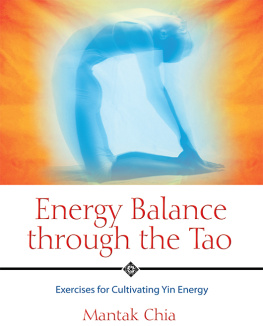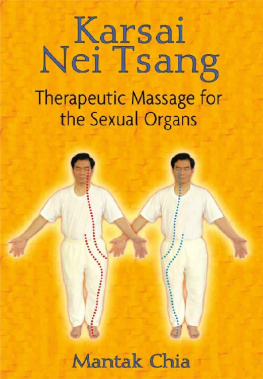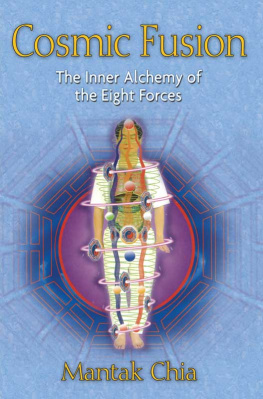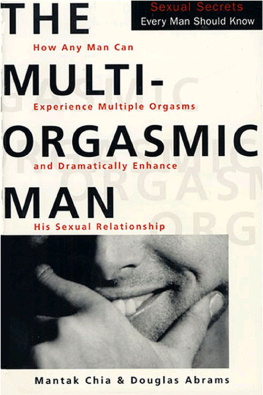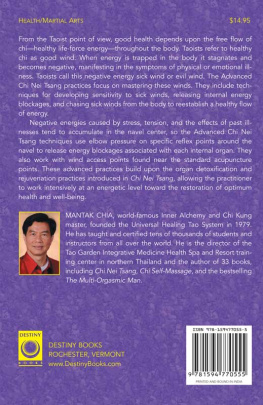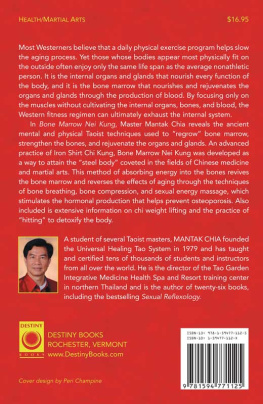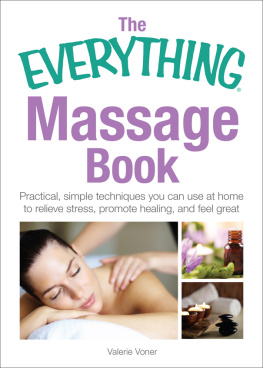
Acknowledgments
I thank foremost those Taoist masters who were kind enough to share their knowledge with me, never imagining it would eventually be taught to Westerners. I acknowledge special thanks to Dena Saxer for seeing the need for this book to be published and for her encouragement and hard work on the initial manuscript.
We wish to thank Nancy Yeilding and Vickie Trihy for editing this new edition of Chi Self-Massage and the following people who contributed to the first edition: Dena Saxer, for writing a portion of this book, especially the basic step-by-step instructions, and for choosing the title; Jo Ann Cutreria, for making so many contacts and working endlessly; Daniel Bobek, for long hours at the computer; John-Robert Zielinski and Adam Sacks for helping with the computer system; Helen Stites and Valerie Meszaros for editing and proofreading; and Gunther Weil, Rylin Malone, and many of my students, for their feedback. Special thanks are extended to Michael Winn, for general editing; to Juan Li, for spending many hours drawing and making illustrations of the bodys internal functions and for his cover illustration; and to Felix Morrow, for his valuable advice and publication of the first edition.
Without my son, Max, the book would have been academic; for his gifts, my gratitude and love.
Putting Chi Self-Massage into Practice
The practices described in this book have been used successfully for thousands of years by Taoists trained by personal instruction. Readers should not undertake these practices without receiving personal transmission and training from a certified instructor of the Universal Tao, because certain practices described, if done improperly, may cause injury or result in health problems. This book is intended to supplement individual training by a Universal Tao instructor and to serve as a reference guide for the Universal Tao practices. Anyone who undertakes these practices on the basis of this book alone does so entirely at his or her own risk. Universal Tao instructors can be located at our Web sites: www.universal-tao.com and www.taoinstructors.org.
The meditations, practices, and techniques described herein are not intended to be used as an alternative or substitute for professional medical treatment and care. If a reader is suffering from a mental or emotional disorder, he or she should consult an appropriate professional health-care practitioner or therapist. Such problems should be corrected before one starts training.
This book does not attempt to give any medical diagnosis, treatment, prescription, or remedial recommendation in relation to any human disease, ailment, suffering, or physical condition whatsoever.
The Universal Tao and its staff and instructors cannot be responsible for the consequences of any practice or misuse of the information contained in this book. If the reader undertakes any exercise without strictly following the instructions, notes, and warnings, the responsibility must lie solely with the reader.
Introduction
The Rejuvenating Power of Chi Self-Massage
From ancient times to the present, Taoist masters have been remarkably youthful, appearing and functioning at least twenty years younger than their actual ages. One source of their vitality has been the practice of Taoist self-massage rejuvenation: using ones internal energy, or chi, to strengthen and rejuvenate the sense organs (eyes, ears, nose, tongue, skin) and the inner organs. These techniques are about five thousand years old and until now were closely guarded secrets passed on from one master to a small group of students. Even so, each master often knew only part of the practice. Based on my studies with a number of different Taoist masters, I have pieced together the entire method and organized the material into a logical routine. By practicing this routine daily, you can improve many aspects of your health, including your complexion, vision, hearing, sinuses, gums, teeth, tongue, and general stamina.
Chi Self-Massage rejuvenation works by clearing blockages from the meridians, or energy channels, of the various senses and vital organs. This is done by the unique Taoist practice of bringing energy, or chi, up from the sexual organs and anus to the face, hands, and senses, and then directing it to specific areas and organs of the body. When the organswhich are believed to store and generate positive and negative emotionsare energized by Chi Self-Massage, they become healthier, which, in turn, fosters positive changes in emotional and personal characteristics.
In my ten years of teaching this simple self-massage, I have seen many people use it to improve their emotional, personal, and social lives. One of my students, for example, had strong fears that easily brought on anger. This resulted in moodiness, irritability, and stomach pain. Naturally, someone who feels this way is unlikely to be very sociable or friendly. After a few weeks of practicing Chi Self-Massage, along with other techniques of Tao rejuvenation, this persons disposition improved, his moodiness decreased, and he became friendlier. He says that since he began studying with me, the greatest benefit has been to his family life, especially his relationship with his children. He no longer needs to use the alcohol he used to rely on to cover up his pain and forget his stress. His employer and coworkers have also noticed the change, and other workers have been encouraged to study the system.
Another person paid for one of her coworkers to study with us, wanting her coworker to find a way to better cope with stress on the job. She later told me that it was the best investment she had ever made, because she no longer had to contend with her coworkers emotional swings.
Chi Self-Massage is only one part of the Universal Tao system of self-development, which enables individuals to complete the harmonious evolution of their physical, mental, and spiritual bodies. Each of my books is an exposition of one important part of this system, and each sets forth a method of healing and life enrichment that can be studied and practiced by itself, if the reader so chooses. However, in the Taoist system each of these methods implies the others and they are best practiced in combination. Therefore I suggest that you also become familiar with the basic practices and exercises that form the foundation of Chi Self-Massage, particularly the Microcosmic Orbit and Inner Smile meditations outlined in the appendix and the Cosmic Healing Sounds outlined in my book Taoist Cosmic Healing. While the present book follows from all that has gone before it, you can begin with this book and learn from it the full range of Chi Self-Massage. Once you begin to practice and experience the benefits of this methodof Taoist rejuvenation, however, you will no doubt wish to master the others, and you will find resources for further study at the Universl Tao Training Center (www.universal-tao.com).
In the pages that follow you will find the techniques for raising and directing chi to bring its rejuvenating effects to all parts of your body, with chapters focusing specifically on the hands, head and sense organs, internal organs and glands, and knees and feet. Special attention is also given to the prevention and treatment of constipation, and the book concludes with comprehensive instructions for a daily practice to maintain abundant emotional and physical health.
Preparing for Chi Self-Massage
A few simple guidelines should be followed to prepare yourself for doing Chi Self-Massage on any of the areas of the body shown in this book:
- Wait at least an hour after eating.
- To obtain the best results, try this practice immediately after doing the Inner Smile, the Microcosmic Orbit meditation, or the Six Healing Sounds (see my book
Next page

